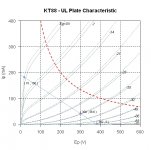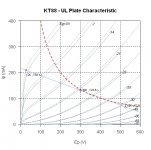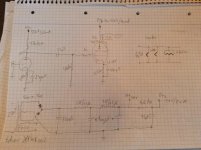Below are two scenarios for your reference:Well, I thought so too, but now I am not so sure anymore. I’ve drawn loadlines, made calculations etc, everything worked out quite nice actually.
1) 300V, -35V, 2k:

2) 300V, -22.5V, 3.5k:

As you can see, the second scenario "looks" better, even without calculating the distortion, we know it is better. Whether you can find such OPT is another matter though...
Swap the positions of the first B+ cap (220uF) and the third B+ cap (100uF). You will get essentially the same filtering action, but a little stiffer B+ to run the KT88.
Also, the transformer B+ secondary will run cooler, with only 1/2 of the transient ((I)squared x R) losses.
The KT88 maximum control grid resistor rating is 220k Ohms for cathode self bias mode. Change the 470k grid resistor to 220k. Thermal runaway is a bad thing, ask me how I know . . . I had a 6550 (similar to a KT88) that had a control grid resistor that was over the max resistance limit. It sounded great for a few minutes. Then I heard distortion and I saw the plate glow red, I turned the amp off in time. A correct grid resistor was installed, and the problem went away.
Edvard Grieg wrote some pretty cool music. Piano Concerto in A (especially the second movement), and Peer Gynt Suite are some of my favorites.
Also, the transformer B+ secondary will run cooler, with only 1/2 of the transient ((I)squared x R) losses.
The KT88 maximum control grid resistor rating is 220k Ohms for cathode self bias mode. Change the 470k grid resistor to 220k. Thermal runaway is a bad thing, ask me how I know . . . I had a 6550 (similar to a KT88) that had a control grid resistor that was over the max resistance limit. It sounded great for a few minutes. Then I heard distortion and I saw the plate glow red, I turned the amp off in time. A correct grid resistor was installed, and the problem went away.
Edvard Grieg wrote some pretty cool music. Piano Concerto in A (especially the second movement), and Peer Gynt Suite are some of my favorites.
Last edited:
Viking83,
You are correct. There are 4 specs for grid resistors.
The original GEC only listed the conservative 2 specs.
P + G2 dissipation <35Watts
Self Bias (Cathode Bias) 470k
Fixed Bias 270k
P + G2 dissipation >35Watts
Self Bias (Cathode Bias) 220k
Fixed Bias 100k
The problem is, which manufacturers only follow the >35Watts resistor specs, no matter what the dissipation is. And which manufacturers do not test their tubes at all, under medium power and full power and various grid resistor values? Want to be conservative, use the 220k / 100k specs.
Your schematic shows 400V - 38V = 362V; and 38V/420 Ohms = 0.090476A. That is 32.75Watts in the plate and screen.
Reminder to those who space their tubes too close together . . . there is another 10.08 Watts in the glass envelope (6.3V x 1.6A filament).
You are correct. There are 4 specs for grid resistors.
The original GEC only listed the conservative 2 specs.
P + G2 dissipation <35Watts
Self Bias (Cathode Bias) 470k
Fixed Bias 270k
P + G2 dissipation >35Watts
Self Bias (Cathode Bias) 220k
Fixed Bias 100k
The problem is, which manufacturers only follow the >35Watts resistor specs, no matter what the dissipation is. And which manufacturers do not test their tubes at all, under medium power and full power and various grid resistor values? Want to be conservative, use the 220k / 100k specs.
Your schematic shows 400V - 38V = 362V; and 38V/420 Ohms = 0.090476A. That is 32.75Watts in the plate and screen.
Reminder to those who space their tubes too close together . . . there is another 10.08 Watts in the glass envelope (6.3V x 1.6A filament).
Last edited:
Thanks for your tips, I will keep them in mind. I guess I messed up the grid leak values, the valve data stated two values depending on biasing technique. Maybe you saved my tubes there
Hi Viking. I have built a handfull of SEP KT88 fixed bias type amps and depending on the OPT if it has UL taps i also hooked them up that way. I always found that Pentode sounds a little better. My current amp is using Edcor 25w 3K OPT, running around 420v.
One good thing about UL is that it is easier to do initial testing since it is a simpler circuit than pentode mode. I had it hooked up in UL for a couple days than added the components for pentode off the B+, around 15H choke, film cap, dropping resistor to G2.
Ok, so nothing to worry about then. Well yes, I live in Vikingdom, and yes, the shipping costs AND snail-mail shipping time might be too long... Edcor might be plenty bang for the buck but doubling the cost in shipping rates, made me wonder if I might as well use something like Hammond.
According to Edcor, the estimated shipping cost for my hardware will be 187 USD with CXSE25-5k OPT. However, if I settle for GXSE15-5k it ends up at nearly half, 232USD in hardware and another 100USD in shipping.
Could the latter OPT work? I’m pushing it on max current on the GXSE, might have to bias it a bit lower... What is the difference in G and C series?
According to Edcor, the estimated shipping cost for my hardware will be 187 USD with CXSE25-5k OPT. However, if I settle for GXSE15-5k it ends up at nearly half, 232USD in hardware and another 100USD in shipping.
Could the latter OPT work? I’m pushing it on max current on the GXSE, might have to bias it a bit lower... What is the difference in G and C series?
Ok, so nothing to worry about then. Well yes, I live in Vikingdom, and yes, the shipping costs AND snail-mail shipping time might be too long... Edcor might be plenty bang for the buck but doubling the cost in shipping rates, made me wonder if I might as well use something like Hammond.
According to Edcor, the estimated shipping cost for my hardware will be 187 USD with CXSE25-5k OPT. However, if I settle for GXSE15-5k it ends up at nearly half, 232USD in hardware and another 100USD in shipping.
Could the latter OPT work? I’m pushing it on max current on the GXSE, might have to bias it a bit lower... What is the difference in G and C series?
The Hammond that is recommended for SE KT88 is even bigger than the big Edcor. And the Hammond cost a lot more too. I used the big Edcor in my SE KT120 amp and they sound very good indeed. I have not tried the Hammond yet so, i don't know how they compare. My other KT88/120 amp uses Electraprint OPT and they also sound very good. It is hard to know which is the better performer just from my ear. Probably you could only find out with an oscilloscope.
I am currently considering Hammonds instead of Edcor, for reasons such as shorter delivery time, they are actually in stock and ready for shipping and total cost will probably end up more or less the same with shipping and customs to Norway... Hammond also have better suited power supply trannies for my needs, I’m thinking Hammond 378x might do the trick. This means I’ll have to redesign/calculate at least the PSU as specs aren’t the same. Might try OPTs from Edcor at some later stage, but for now my first priority is progress with my amplifier
Went with Hammond OPTs and chokes, found some at a very nice price. Mains transformer will be ordered from Noratel over here in Norway, the few I found with sufficient amperage and voltage are enormous and cost a lot to ship.
Took a chance and ordered another E80CC of Ebay, supposed to be an old military tube. Are there any particular differences between military grading and common commercial samples?
Took a chance and ordered another E80CC of Ebay, supposed to be an old military tube. Are there any particular differences between military grading and common commercial samples?
Typically, mil spec tubes are selected for tighter tolerances and or matched sections. There were some tubes designed especially for the military used in guided missiles and aeronautics that were made to tolerate high g force and vibration, not typical in regular commercial use.
- Status
- This old topic is closed. If you want to reopen this topic, contact a moderator using the "Report Post" button.
- Home
- Amplifiers
- Tubes / Valves
- E80CC/KT88 SE Triode/UL question
